Harvard English professor Marjorie Garber called for more positive patronage of the arts—support that nurtures rather than constricts the artist’s freedom—by public and private institutions in a discussion of her new book last night at the Harvard Book Store.
Garber—a world-renowned expert on Shakespeare, chair of the Department of Visual and Environmental Studies and director of the Carpenter Center for the Visual Arts—discussed the paradox of patronizing the arts, namely how benefactors can potentially stifle the creative freedom of artists.
To a small audience, Garber said, “The arts are doubly patronized: we are supporting artists, but we are not granting them serious partnership.” She explained that art of all forms—visual, performance and literary—is often seen as recreation and not as serious work.
Garber’s new book, “Patronizing the Arts,” came out earlier this year and takes this topic as its focus.
The risk of suppressing the creativity of artists is increased, Garber said, when art is supported by non-neutral institutions, such as governments, which may seek to conform art to their own expectations or beliefs.
Garber also noted the tension between the commercial and the exploratory sides of art, stating that while “older art is deeply valued, newer art is sometimes suspect.” Patrons are wary of supporting risky, edgy and unsanctioned art, which may be less commercially successful than art that is traditional and accepted, she said.
Audience members who were involved in the arts said they agreed with many of Garber’s points.
Susan H. Skoog, a fiber artist and student at Simmons College, said, “Patrons definitely influence your work. There’s a tension between making what you want versus simply making what sells well.”
Garber concluded that it is the newer art that most needs patronage, stressing the importance of “pressing the boundaries.”
Cambridge resident Susan White-Shaffer, a long-time painter, said she was interested in Garber’s comparison of art and science. “Both are inquiries into the truth and complexity of life.”
Garber’s book comes at a time when Harvard is in the midst of an effort to revitalize the arts on campus. University President Drew G. Faust created a 20-person task force last year to evaluate the role of arts at Harvard. The task force is chaired by fellow English Professor Stephen Greenblatt, in addition to student and faculty membership. The College unveiled new secondary fields in music and dramatic arts, giving more recognition to what used to be offered only as extracurricular activities.
During the talk, Garber said she was anticipating the task force’s report, which will be released later this fall. While praising the University’s efforts to reinvigorate the arts, she also made some recommendations of her own.
“We can certainly use more studio and rehearsal space and involve more people in the arts,” she said.
Read more in News
Meghan McCain Visits BostonRecommended Articles
-
No HeadlineART AT PHNCETON. -Preparations are now being made for the opening of the new art school during the coming winter
-
Celebrating Le Corbusier’s Carpenter CenterAppropriately enough, it was the ramp of the Carpenter Center for the Visual Arts (CCVA) that bore its christening on
-
Bard Plays Lead for GarberFor Marjorie Garber, a 392-year-old English playwright is of real importance to today’s world. Indeed, even after having written five
-
Shakespeare, 'Tis Modern Culture and Modern Culture, 'Tis Shakespeare“The premise of this book is a simple and direct one: that Shakespeare makes modern culture and that modern culture
-
 Tedeschi Named Next Art Museums Director
Tedeschi Named Next Art Museums Director













